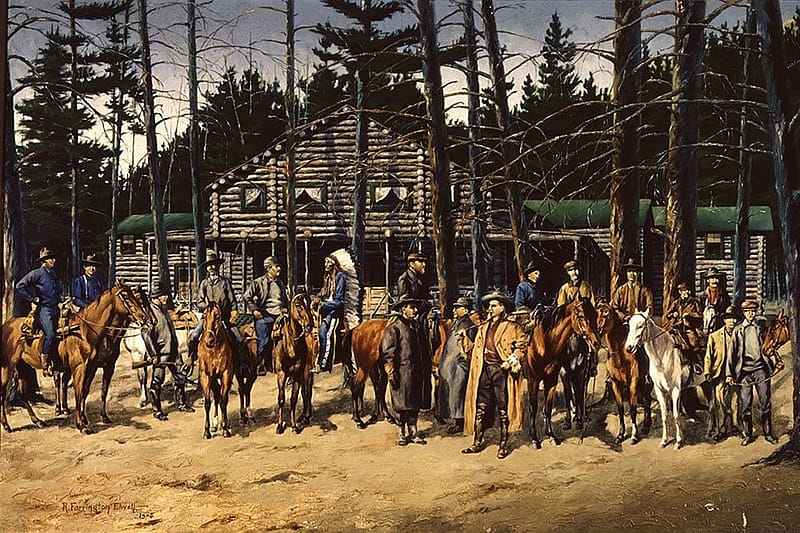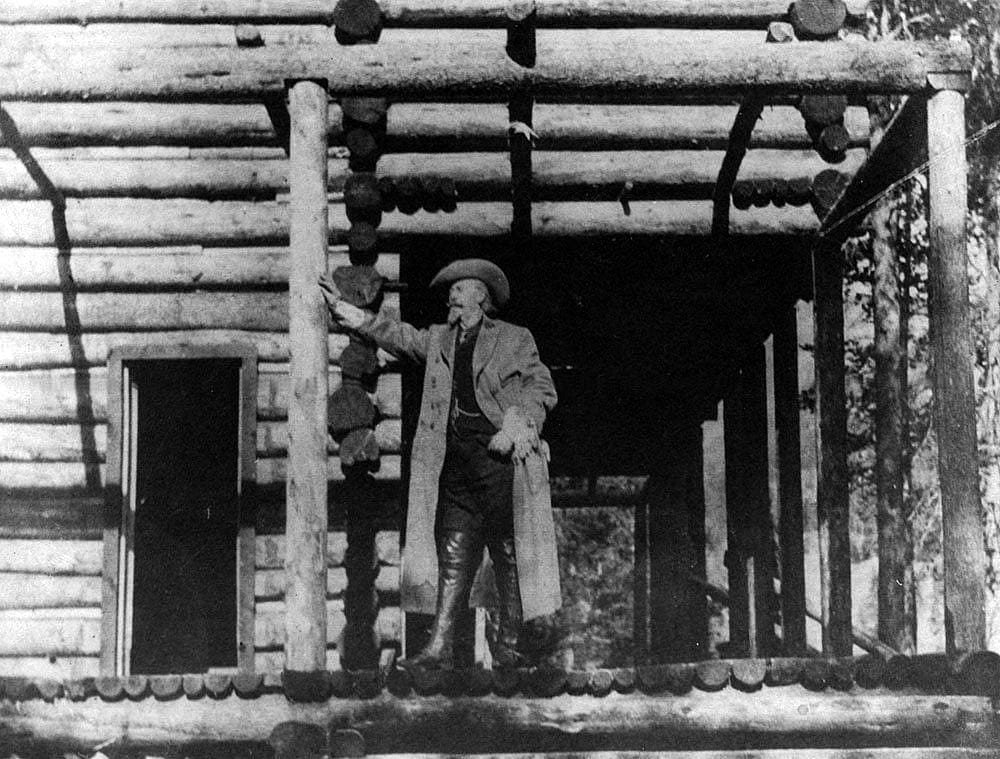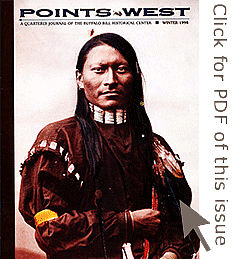
Pahaska Tepee – Points West Online
Originally published in Points West magazine in Winter 1998
Pahaska Tepee: “The Gem of the Rockies”
By Joanita Monteith, Guest Author
Buffalo Bill Cody’s Wild West and Pawnee Bill’s Great Far East Shows merged for the 1908 season and managed a six-year run before culminating to bankruptcy in Denver Unofficially, the combined shows were known as “The Two Bills Show.” Cody’s busy schedule was taxing at times, and in 1909 he told his partner, Gordon Lillie (Pawnee Bill), that he longed for his hunting lodge, Pahaska Tepee near Cody, Wyoming.
“…by the time the season closes, I am just about all in. The constant noise and turmoil, both day and night, wears on a fellow. I can hardly wait til I reach my hunting lodge.” He often referred to the place as “The Gem of the Rockies.”
Despite Buffalo Bill’s longing for Pahaska, newspaper accounts recorded that Cody visited there not more than six times in his lifetime. During some of the best known hunts at Pahaska, such as the 1913 visit by the Prince of Monaco, Buffalo Bill did not hunt, but rather played the host.
The precise site for Pahaska Tepee was marked out with an ax by Buffalo Bill in 1901. The spot is about 50 miles west of Cody near the east entrance to Yellowstone National Park in the Absaroka Mountains at 6,672 Feet. Pahaska Tepee was named at the suggestion of Buffalo Bill’s Lakota friend, Iron Tail. Pahaska probably comes from “pahinhonska,” Buffalo Bill’s Lakota name, which means long hair of the head. Tepee is Lakota for lodge. The name is literally Long Hair’s lodge.

It is doubtful that much construction took place at Pahaska until 1903 when logs were probably felled and notched and the foundation prepared. After the government road was completed from Cody, Wyoming, to the east gate of Yellowstone National Park in the summer of 1903, wagon loads of purchased building materials were hauled to the site. The building was erected on leased federal land which was not available for purchase.
The lodge was opened for business in 1904, but construction continued into 1905. Pahaska’s main lodge was designed by A.A. Anderson, founder of the Palette Ranch at Meeteetse. Construction was supervised by Buffalo Bill’s friend, Dr. Frank Powell.
While Pahaska was under construction, her sister hotel, Wapiti Inn, was being built for Buffalo Bill on the same government road, about 30 miles west of Cody. Pahaska Tepee and Wapiti Inn were part of Buffalo Bill’s overall plan to promote his interests and to help develop the town that was his namesake. His plan was to have three hotels extending from Cody to the east gate of Yellowstone National Park as soon as the government wagon road from Cody to the Park was completed and a railroad line was extended to Cody from Toluca, Montana. The hotels included The Irma, in Cody near the railhead; Wapiti Inn, a half-day’s wagon ride west of Cody, and Pahaska Tepee, a day’s ride west at the east gate of the Park.
While Pahaska was built as Buffalo Bill’s fall hunting lodge where he could entertain his world circle of friends, it was mainly intended to be a summer hotel that produced a profit. As with many of Buffalo Bill’s business projects, Pahaska was eventually financially successful. However, he underestimated the length of time it would take to reach profitability.
Buffalo Bill’s original hunting lodge building at Pahaska is a T -shaped, two-story log building with a large wrap-around porch on three sides. The main floor has seven bedrooms, a kitchen, a dining room and a large lounge with a massive free-standing native stone fireplace, which accommodates five-foot logs. The second floor houses Buffalo Bill’s private suite, extending over the porch, as well as six other bedrooms and two baths.

Although Pahaska Tepee originally referred only to the main hunting lodge, other buildings were added to the site during Buffalo Bill’s ownership. Improvements included adding four, two-room log cabins southwest of the main lodge in 1909. In addition, a circular shaped, canvas-roofed, log dance pavillion, a log laundry building, a rifle range, and tennis and croquet courts were added in 1911. The following year an auto club house was built. In 1913, Wapiti Inn was torn down, and its lumber was hauled to Pahaska where it was used to construct a bunkhouse.
After Buffalo Bill’s death in 1917, Pahaska had a series of owners until 1926 when it was taken over by Alberta Wilkinson. She and her son, Willard, added the log store to the site in 1929. They closed the dining room in the Lodge and converted it to a museum in 1939 – 1940. In 1946, Mrs. Wilkinson sold out to Henry H.R. and Peg Coe, who expanded winter activities at Pahaska, particularly skiing. During their ownership, the Coe’s extensively remodeled the property, including removing a 1921 addition on the west side of the old Lodge.
Today, Pahaska is a full-service resort in summer and a ski and snowmobile center in winter. It is still owned by the Coe Family and is managed by Robert Coe II. The property and its buildings have special significance to locals and to tourists because of their early association with Buffalo Bill. Today, the site includes more buildings than Buffalo Bill’s original hunting lodge. In 1993, Prince Albert of Monaco visited the site, commemorating his ancestor’s 1913 hunt at Pahaska.
Ed. note: And in 2013, Prince Albert II of Monaco visited as well, again commemorating his great great grandfather’s visit in 1913.
Post 136
Written By
Nancy McClure
Nancy now does Grants & Foundations Relations for the Center of the West's Development Department, but was formerly the Content Producer for the Center's Public Relations Department, where her work included writing and updating website content, publicizing events, copy editing, working with images, and producing the e-newsletter Western Wire. Her current job is seeking and applying for funding from government grants and private foundations. In her spare time, Nancy enjoys photography, reading, flower gardening, and playing the flute.










